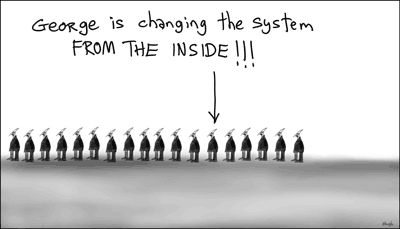The previous post Resistance To Change gave ideas why some people fear change. If you know how to calm these fears, you will be able to turn critics into allies. Here are some ideas on how to deliver your ideas:

Be Open and Honest
Document your entire plan including execution, cost, risk, and expected rewards. In short, lay all of the cards out on the table, both the good and the bad. Being 100% honest about your plans will eliminate many different fears.
- Hidden Agendas – All hidden agendas are eventually revealed. Whether you will personally gain or not, by showing that you have nothing to hide gives you instant creditability and stops all the gossip about your intents. This allows everyone to concentrate on the plan and not you.
- “The Unknown” – Sometimes skepticism only comes from not having all of the facts. This allows those people to have all aspects of the proposed change in black and white.
- Feeling of no control – Some folks feel the need to criticize before giving their blessing, and this gives them the needed opportunity. Besides, it might be healthy to hear different criticism.
Relinquish Credit
Get over your ego, and let go of the credit. The idea probably is not unique (maybe to your organization but not the world).
Most important, the quickest way to make your friends into enemies is by using the letter ‘I’. When you start saying “I developed this plan….I wrote this document…” you are excluding all your other team members from any credit. Credit is overrated. Even if your team did nothing, give them some credit for being “very accepting” and not being in your way. If your team had a lot of criticism, thank them for all the great feedback.
In the end, your boss is not as stupid as you would like to think. Most managers know who actually did the work. As a result, they also know who to reward when a plan is executed correctly. You will be viewed as not only a hero but also a humble team player.
Sympathize
Fear of loss, feelings of discomfort, or lack of confidence can paralyze people into not changing. To turn these petrified persons into allies you will need to show some TLC and sympathy.

Claim you have read books such as Letting Go of Your Bananas. Explain that you too feel those feelings, but letting go is the first step to moving forward.
Therapists sympathize with their clients everyday. Does the sympathetic shoulder of a therapist need to be sincere? No and neither does yours, but willingness to sympathize shows humanity and understanding. Consequently, petrified persons will view you as non-confrontational and be more open to your ideas.
Educate
Never assume that people completely understand the topic at hand. When starting communications, it is important to lay down a baseline of education. This way you have assurance that everyone is on some basic level of understanding about your idea or change.
For example, let’s assume that you are attempting to push your development team to use a Continuous Integration server. It is dangerous to assume that all involved has researched Continuous Integration. Saving possible embarrassment to the uneducated, starting conversations with phrases such as “To start, let’s review so we are all on the same page…” is preferred. In the end, you have given yourself a chance to realign your audience’s mental picture to yours.
Use Buzz Words
Sometimes there is no educating people. The divide between reality and their fictitious world is too great. In these instances throwing out some buzz words can help your cause greatly. This technique only works for people that need assurance you are on the right track, but are not willing to understand what the hell you are talking about. Some pitches can sound as if they came from the Dilbert Mission Statement Generator. As an example:
“This will be a Web 2.0 application built on Microsoft technology. This will jump us to the next curve of synergy and communication…”
What a bunch of crap, but do not underestimate the results. In the speech The Art of Innovation Guy Kawasaki tells a story of a generated Dilbert mission statement which came in 2nd place at a company executive retreat.
Compromise
Let’s admit it, your idea is probably not perfect and neither are you (or me). As a result your idea is drawing criticism, but what to do? Use this criticism for what it is – great feedback. With the collected feedback you can refine your ideas and present them as “compromises”. People will appreciate you considered their ideas, thus giving your ideas more room to maneuver.
So what if your organization is not completely ready for your changes or ideas? Changes do not need to be an all or nothing affair. Compromising is a terrific stepping-stone to implementing your ideas. Take your initial idea and start breaking it into smaller implementations. With each small implementation your environment is gradually changed through a series of compromises.
Rally a Support Group
Getting great ideas validated rarely comes from pitches done by a single person. If there are supporters within your organization, do not be afraid to ask these people if you can use their name in support. Having one or more supporters in meetings can quickly validate ideas and sway opinions. If it is not practical to have multiple people in the meeting, be sure to throw out your supporters names and opinions. This brings their ideas and political weight into the conversation even if they are not physically there.
Suck up
Hey, why the hell not. If it gets you what you want, it is a dog-eat-dog world. By the way…you look good today…you should subscribe to my blog…
Since there are countless ways to pitch ideas, it is best practice to first understand your audience. Some personalities need to be coddled, while others need to be firmly directed. Your ability to read your audience will help you chose the best form of delivery.




